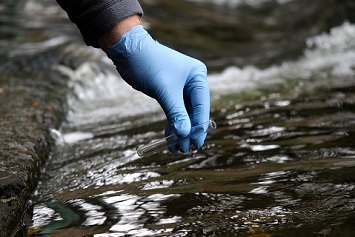With several states’ deadlines for discharge monitoring reports (DMRs) looming, it’s a good time of year to get back to basics and evaluate your industrial facility’s stormwater monitoring practices. Forgetting to monitor or improperly monitoring can lead to a number of costly violations for facilities operating under industrial stormwater permits, so it pays to make sure you’re doing things right.
One of the biggest stumbling blocks for industrial facilities is often basic preparation. Because stormwater sampling is not a regular part of a facility’s workload, it is easy to forget to meet monitoring requirements and to end up struggling to get samples and reports done before the deadlines pass. By reviewing strategies to prevent a last-minute scramble, you can ensure that your facility’s monitoring goes smoothly when the rain starts to fall.
What You Don’t Know Can Hurt You
Before you collect your samples, it’s important to be aware of several site-specific factors so you can conduct your monitoring properly and quickly. Know where the outfalls, or places where stormwater discharges, are on the grounds and around the perimeter of your facility, and which outfalls are designated as appropriate sample locations. You should also know which types of monitoring, such as visual assessments, benchmark monitoring, effluent limitations monitoring, or impaired waters monitoring, should be conducted at each outfall.
You will also want to know who is on your stormwater monitoring team, how to contact them when it’s time to sample, and which laboratory they should send the samples to once collected.
Perhaps most importantly, know your monitoring and reporting deadlines! These dates should be clearly outlined in your stormwater permit, and keeping on top of your schedule will help prevent you from violating your reporting requirements.
Though most of this information should have been gathered when your facility applied for its stormwater permit and developed its stormwater pollution prevention plan (SWPPP), it’s essential to make sure that every member of your stormwater monitoring team is familiar with these fundamentals before samples need to be taken.
Waiting for a Rainy Day
Another thing to keep in mind when creating a successful stormwater monitoring program is how to identify which types of storm events qualify for monitoring and when they occur. A “measurable storm event” is typically a storm or snowmelt that creates an actual discharge from your site and that occurs at least 72 hours after a previous measurable storm event. Tracking the weather is one of the more problematic areas for facilities, but if you familiarize yourself with your local precipitation trends, storm patterns, and seasonal variations and keep up with the precipitation forecasts in your area, you can stay ahead of the curve when it comes time to take your stormwater samples.
Check Your Gear
The final consideration you need to think about when preparing for stormwater monitoring is whether you have all of the necessary sampling supplies. Equipment to have on hand include:
- Clean sterilized sample bottles that are appropriately labeled in waterproof ink and that are the correct size and material for the type of sample to be analyzed;
- Additional bottles for any required visual assessments;
- Chain-of-custody forms;
- Monitoring forms;
- A pole for attaching sample bottles and any necessary attachment clips or strapping tape;
- pH paper and appropriate chemical preservatives for adding to sample bottles;
- Safety equipment, including a first-aid kit;
- Hand sanitizer solution;
- Powder-free disposable nitrile or latex gloves;
- Permanent pens or markers that can write on wet surfaces;
- Foul-weather gear, including footwear appropriate for the conditions at the sampling locations; and
- A cooler and ice or ice packs for storing and preserving the samples for transport to the lab.
By gathering these and any other items that your facility uses to collect stormwater samples ahead of time, you and your stormwater monitoring team will be ready to act quickly when the next storm event rolls around.
Now What?
Once you complete the above steps, you will be fully prepared to collect and report the stormwater samples. As a result, you can prevent expensive, common, and avoidable violations caused by forgetting to properly complete required discharge monitoring for your industrial facility.

